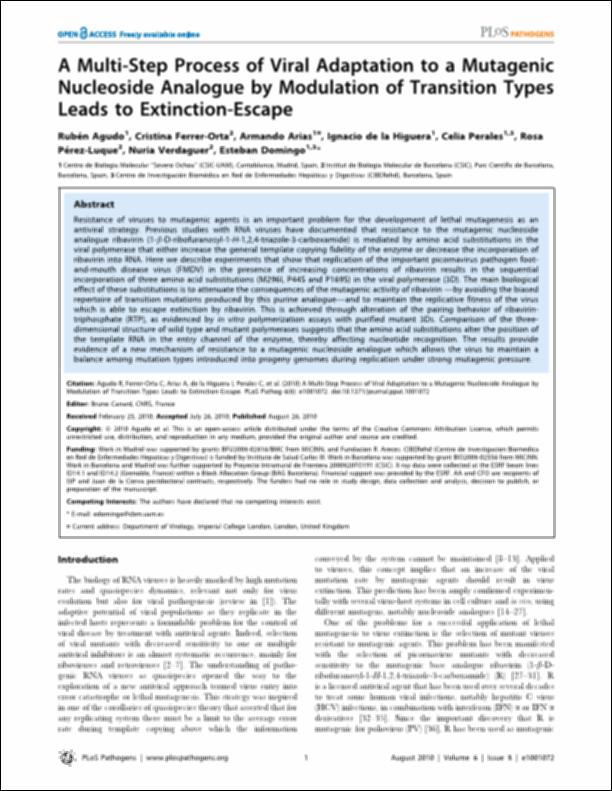Please use this identifier to cite or link to this item:
http://hdl.handle.net/10637/15684A Multi-Step Process of Viral Adaptation to a Mutagenic Nucleoside Analogue by Modulation of Transition Types Leads to Extinction-Escape
| Title: | A Multi-Step Process of Viral Adaptation to a Mutagenic Nucleoside Analogue by Modulation of Transition Types Leads to Extinction-Escape |
| Authors : | Agudo Torres, Rubén Ferrer-Orta, Cristina Arias, Armando Higuera, Ignacio de la Perales, Celia Pérez-Luque, Rosa Verdaguer, Nuria Esteban, Domingo |
| Keywords: | RNA viruses; Mutagenic agents |
| Publisher: | Public Library Science |
| Citation: | Agudo R, Ferrer-Orta C, Arias A, de la Higuera I, Perales C, Pérez-Luque R, et al. (2010) A Multi-Step Process of Viral Adaptation to a Mutagenic Nucleoside Analogue by Modulation of Transition Types Leads to Extinction-Escape. PLoS Pathog 6(8): e1001072. https://doi.org/10.1371/journal.ppat.1001072 |
| Abstract: | Resistance of viruses to mutagenic agents is an important problem for the development of lethal mutagenesis as an antiviral strategy. Previous studies with RNA viruses have documented that resistance to the mutagenic nucleoside analogue ribavirin (1-β-D-ribofuranosyl-1-H-1,2,4-triazole-3-carboxamide) is mediated by amino acid substitutions in the viral polymerase that either increase the general template copying fidelity of the enzyme or decrease the incorporation of ribavirin into RNA. Here we describe experiments that show that replication of the important picornavirus pathogen foot-and-mouth disease virus (FMDV) in the presence of increasing concentrations of ribavirin results in the sequential incorporation of three amino acid substitutions (M296I, P44S and P169S) in the viral polymerase (3D). The main biological effect of these substitutions is to attenuate the consequences of the mutagenic activity of ribavirin —by avoiding the biased repertoire of transition mutations produced by this purine analogue—and to maintain the replicative fitness of the virus which is able to escape extinction by ribavirin. This is achieved through alteration of the pairing behavior of ribavirin-triphosphate (RTP), as evidenced by in vitro polymerization assays with purified mutant 3Ds. Comparison of the three-dimensional structure of wild type and mutant polymerases suggests that the amino acid substitutions alter the position of the template RNA in the entry channel of the enzyme, thereby affecting nucleotide recognition. The results provide evidence of a new mechanism of resistance to a mutagenic nucleoside analogue which allows the virus to maintain a balance among mutation types introduced into progeny genomes during replication under strong mutagenic pressure. |
| URI: | http://hdl.handle.net/10637/15684 |
| Rights : | http://creativecommons.org/licenses/by-nc-nd/4.0/deed.es OpenAccess |
| ISSN: | 1553-7374 |
| Issue Date: | 26-Aug-2010 |
| Center : | Universidad San Pablo-CEU |
| Appears in Collections: | Facultad de Farmacia |
Items in DSpace are protected by copyright, with all rights reserved, unless otherwise indicated.


